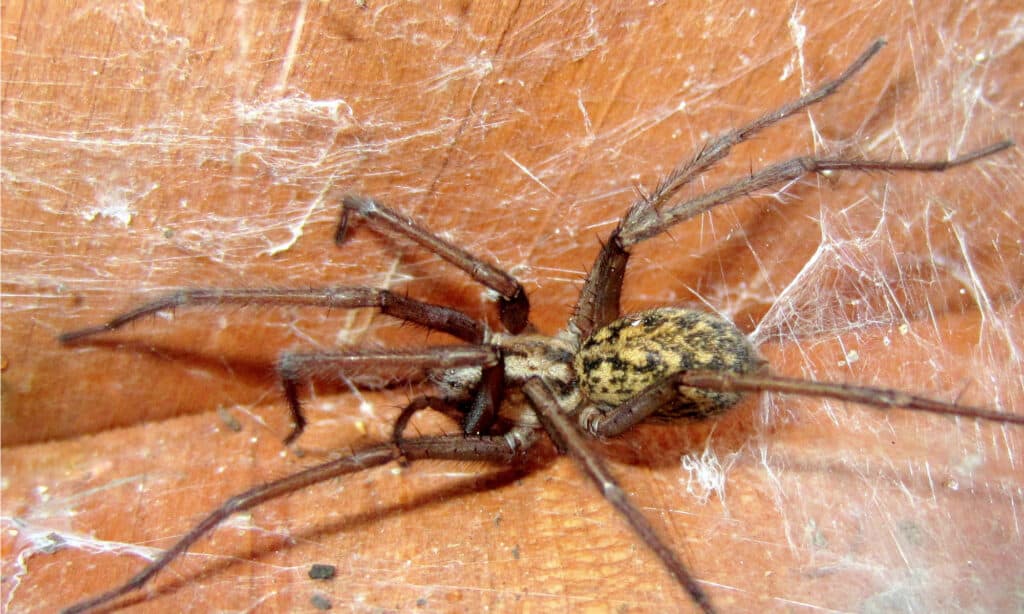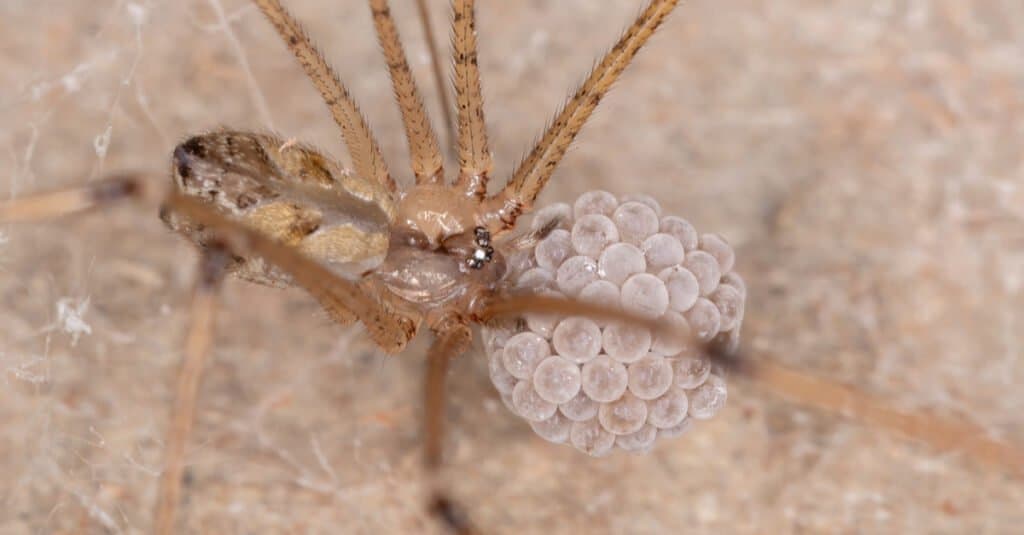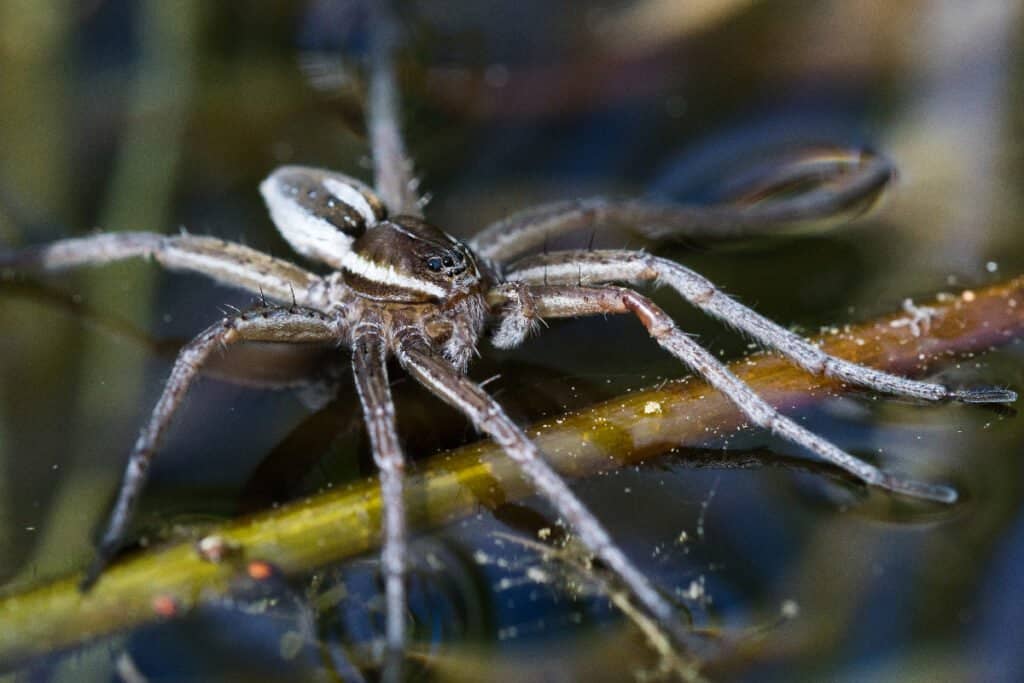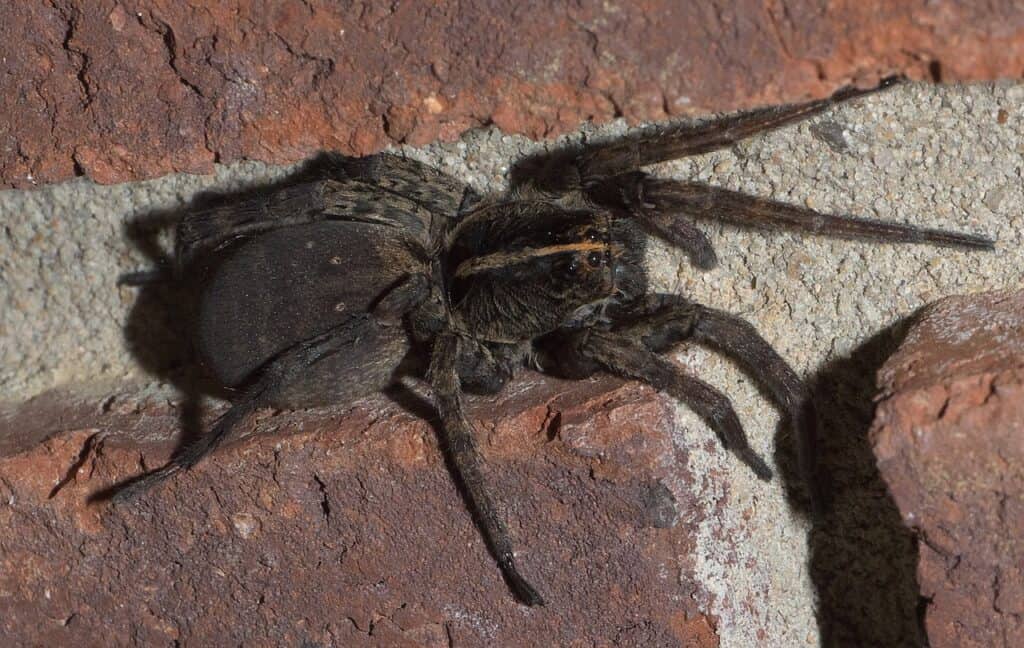Montana is renowned for its vast expanses of pristine land, incredible views of nature, and a wealth of natural resources. Sure, this state is home to some very large and dangerous animals, but they share a range with smaller ones, including spiders. Today, we’re going to look at those arachnids and show you some of the biggest spiders in Montana. That way, the next time you’re fishing and see a massive spider run across the surface of the water, you’ll know what it is!

What Are the Biggest Spiders in Montana?
Although it’s a very large state, the biggest spiders in Montana aren’t necessarily the largest ones found in the entire country. Instead, these spiders mostly range from 2 to 3 inches in total length, including their legs, though some larger species and individuals may exist too.
We’re not just going to focus on their length, though. Instead, we’re going to show you what these spiders look like and if they can cause serious to a person with their bite.
5. Hobo Spider

The hobo spider grows to about 2 inches.
©Randy Bjorklund/Shutterstock.com
| Scientific Name | Size | Danger to Humans |
|---|---|---|
| Eratigena agrestis | 1-2 inches | A bite can cause moderate pain and some redness at the site, but they’re not deadly. |
The hobo spider was believed to be a dangerous spider as recently as a few decades ago. Originally, scientists thought this creature could deliver a necrotizing bite. Yet, that turned out not to be true as recent studies have attested. It’s believed that other spiders were the true culprits for necrotizing bites, and the hobo spider simply got the blame.
This spider grows to a length of about 2 inches in total length, and it can bite humans. However, you don’t need to be worried about their bites that much. A person will experience moderate pain and a little bit of redness at the site that quickly resolves.
The spider is brown and tan with a light brown marking running the length of its carapace and two dark marks on the border of that stripe. It also has a mottled abdomen. If that sounds plain, that’s because it is, making it hard to identify this spider compared to others.
4. Forest Wolf Spider

As their name suggests, forest wolf spiders are usually found in the forest.
©Paul Reeves Photography/Shutterstock.com
| Scientific Name | Size | Danger to Humans |
|---|---|---|
| Hogna frondicola | 0.5-2 inches | A bite will cause mild pain, itchiness, and swelling around the bite area. |
The forest wolf spider is not the largest member of the Hogna genus in Montana. Yet, it can still grow 2 inches in length or a little more. These spiders are usually found running around on the ground of places where there is an adequate degree of cover, like rocks, logs, and other vegetation. Thus, you can certainly find them in forests.
They are known for having brown, black, and gray bodies. They have a thick gray stripe that runs the length of their carapace and a light-colored “face.” Their abdomen has a large light mark with edges of dark brown or black.
Although people fear these creatures, they aren’t that dangerous. They can bite people, but they have to be coaxed into doing so with repeated aggravations. Their bites are mildly painful, and they may cause some itchiness and swelling in the area. Like other wolf spiders, it’s possible to be allergic to their venom, and that requires a medical evaluation and treatment.
3. Long-Bodied Cellar Spider

Cellar spiders are named for their favorite homes.
©iStock.com/ViniSouza128
| Scientific Name | Size | Danger to Humans |
|---|---|---|
| Pholcus phalangioides | 1-2 inches | A bite may cause a mild burning sensation. |
The long-bodied cellar spider is known for hiding out in people’s basements and garages. It builds its webs in the corners of high-up locations in those areas and waits for prey. It has a small, peanut-shaped body that can be brown, tan, or grayish brown.
Unlike many of the spiders on this list, these spiders’ bodies have a translucent quality to them. When you consider that quality along with the fact that they have very long legs, sometimes present with a skull-shaped mark on their carapace, and can make their webs vibrate to make them harder to see, it’s clear that they’re creepy.
Although they’re not pleasant creatures to have in your home, they aren’t harmful to humans. Instead, in the rare event that they actually bite, you’ll feel a minor burning pain. Aside from that, these spiders are useful at killing truly harmful species, like the black widow.
2. Six-Spotted Fishing Spider

The six-spotted fishing spider has six spots on its abdomen.
©Jukka Jantunen/Shutterstock.com
| Scientific Name | Size | Danger to Humans |
|---|---|---|
| Dolomedes triton | 0.35-2.4 inches | Bites will induce swelling and some pain similar to a bee sting. |
The Dolomedes genus has some of the biggest spiders in Montana within its ranks. Although the six-spotted fishing spider is not the largest, it is one of the most recognizable.
Like other fishing spiders, this one is frequently seen living near water. It spends time on docks and boats when it is not actively hunting its prey. Dark fishing spiders hunt aquatic and terrestrial insects on the water surface, and they can even dive below the waves to grab tadpoles and small fish.
This spider has a mostly dark brown body but has a white stripe running down both sides of its carapace and abdomen. The abdomen and legs are usually spotted with white, but that is not where they get their name. Instead, they have six dark spots on the ventral aspect of their abdomen.
You’re not likely to see that, though. They run from humans even though they can bite. Don’t worry, though, a bite from this spider is only as bad as a bee sting.
1. Large Wolf Spider

The grand wolf spider is the biggest spider in Montana.
©xpda / CC BY-SA 4.0 – License
| Scientific Name | ||
|---|---|---|
| Tigrosa grandis | 2-3 inches | Issues a moderately painful, itchy bite that swells in the area |
Although this spider doesn’t have a common name, calling it the grand wolf spider feels appropriate since it is one of the biggest spiders in Montana. This spider usually presents with a dark brown or black body that features a reddish-brown or brown stripe running down the middle of its carapace.
Furthermore, this spider may have mottled legs that turn into bands on the tibia. These spiders are large and quick like other wolf spiders, but they tend to avoid people. They can be found wandering on the ground, in wood piles, in the basements of homes, in small burrows, and in many other places.
Even though you can spot them by lifting rocks or turning over logs, it’s a good idea to leave them alone. While they’re not overly aggressive, they can bite a person, potentially causing adverse health effects in people that are allergic to their venom.
Now that we’ve covered all the biggest spiders in Montana, let’s turn our attention to spiders that are actually dangerous to humans. In this state, the black widow is the most dangerous spider in Montana. Its bite can cause sweating, cramping, and neurological damage. Though rare, a black widow bite can be fatal. Make sure you know how to recognize and safely dispose of or avoid these creatures.
Summary of 5 of the Biggest Spiders in Montana
| Rank | Spiders |
|---|---|
| 1 | Large Wolf Spider |
| 2 | Six-Spotted Fishing Spider |
| 3 | Long-Bodied Cellar Spider |
| 4 | Forest Wolf Spider |
| 5 | Hobo Spider |
The photo featured at the top of this post is © iStock.com/randimal
Sources
- Missouri Department of Conservation (1970) mdc.mo.gov/discover-nature/field-guide/wolf-spiders
- PennState Extension (1970) extension.psu.edu/longbodied-cellar-spider
- Web MD (1970) webmd.com/a-to-z-guides/what-you-need-to-know-about-a-wolf-spider-bite#:~:text=Wolf spiders don't pose,it shouldn't last long
Thank you for reading! Have some feedback for us? Contact the AZ Animals editorial team.







